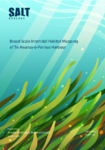Broad Scale Intertidal Habitat Mapping of Te Awarua-o-Porirua Harbour 2020 Survey
Search in document library
The gradual increase in the spatial extent of mud-dominated sediment has resulted in expansion of the northeast intertidal flats of Pāuatahanui Inlet causing associated ecological changes. Of concern is the significant loss of seagrass and salt marsh relative to estimated historic conditions, with a 43% decline in salt marsh between 2013 and 2020. Small hotspots of persistent opportunistic macroalgal growth were apparent, but the reduced area of impact may be related to the deposition of muddy sediment in the Kakaho and Horokiri areas, which provides poor habitat for macroalgal growth. Despite conspicuous green mats of Chaetomorpha ligustica smothering the seabed, only 0.1% of the intertidal area was enriched.
Reference: Stevens LM, Forrest BM. 2020. Broad Scale Intertidal Habitat Mapping of Te Awarua-o-Porirua Harbour. Salt Ecology Report 050, prepared for Greater Wellington Regional Council, October 2020. 46p.
Author/s: Leigh Stevens and Barrie Forrest. Salt Ecology